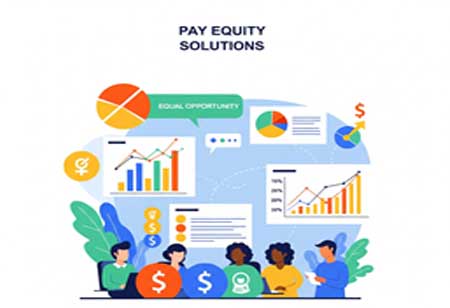THANK YOU FOR SUBSCRIBING
Be first to read the latest tech news, Industry Leader's Insights, and CIO interviews of medium and large enterprises exclusively from Hrtech Outlook
THANK YOU FOR SUBSCRIBING

By
HR Tech Outlook | Monday, October 13, 2025
Stay ahead of the industry with exclusive feature stories on the top companies, expert insights and the latest news delivered straight to your inbox. Subscribe today.
Pay equity ensures that employees receive equal pay for work of equal value, and has become a central priority for organisations across Europe. As economic, social, and legal pressures mount, businesses are expected not just to comply with evolving regulations but to actively close unjustified pay gaps based on gender, ethnicity, age, and other biases. Pay equity solutions have emerged as indispensable tools for organisations aiming to achieve fair, transparent, and data-driven compensation systems.
The solutions encompass software platforms, data analytics tools, consulting services, and compliance tracking mechanisms that enable the identification, correction, and prevention of pay disparities across the workforce. In Europe, where regulations are reshaping employer responsibilities, implementing robust pay equity solutions is no longer optional; it’s a strategic imperative tied to reputation, talent retention, and regulatory compliance. Pay equity solutions are applicable across nearly every industry in Europe, but their adoption is particularly high in sectors subject to intense regulatory scrutiny or those facing competitive labour markets.
Driving Forces Behind the Adoption of Pay Equity Solutions
Many countries, including France, Germany, and Sweden, have already introduced national laws requiring gender pay audits and equal pay certifications. The frameworks create an environment where companies must track pay data and actively demonstrate how they are closing equity gaps. It has prompted businesses to transition from manual pay audits to tech-enabled, real-time equity monitoring platforms. Consumers, employees, investors, and advocacy groups are increasingly holding companies accountable for social equity. Younger generations, particularly Gen Z and Millennials, prioritise working for organisations with inclusive cultures and ethical business practices.
Pay equity is viewed as a legal responsibility and as a core part of an employer’s brand identity and value proposition. The technological implementation of pay equity solutions has become more sophisticated and scalable. Cloud-based analytics platforms now integrate seamlessly with HR and payroll systems to assess compensation data across roles, locations, and demographic groups. They help companies comply with local legal frameworks by generating standardised reports for authorities. Some solutions offer real-time dashboards, allowing leadership to view equity metrics during promotions, new hires, and bonus decisions.
Predictive models can help HR teams proactively forecast risks and avoid pay inequity in future compensation cycles. Among emerging trends is the normalisation of salary transparency. European companies are increasingly disclosing pay bands in job postings and utilising public salary calculators to attract a diverse talent pool. Gamification and employee feedback loops are gaining traction, allowing workers to self-assess and anonymously query compensation gaps. Cross-border compliance solutions are being developed to help multinational organisations manage equity across varying national laws.
Addressing Challenges in Pay Equity Solutions
The deployment of pay equity solutions presents several challenges. A key issue is data inconsistency. Many European companies lack standardised compensation data across departments or regions, especially those operating in multiple countries. It makes it difficult to perform accurate audits or draw meaningful conclusions from equity reports. The solution lies in data harmonisation, centralising payroll, job architecture, and demographic data using modern HRIS (Human Resource Information Systems) and payroll integrations. Some platforms offer built-in data cleaning and benchmarking capabilities to automate this process.
Some businesses fear that equity audits may reveal significant gaps that require costly corrections or reputational damage from transparency. Overcoming this requires change management, including education around long-term ROI, brand value, and legal risk mitigation. Consulting firms that specialise in pay equity now offer workshops and executive coaching to help organisations embed a culture of fairness from the top down. Each European country has unique employment laws, reporting formats, and definitions of equal work. It creates confusion, especially for multinational firms.
Many pay equity solution providers are developing compliance modules that adapt to regional laws and automatically generate reports in the required formats. These modules are updated regularly in response to changes in national directives or case law. An often-overlooked obstacle is the lack of clear job architecture. Without standardised job roles and levels, comparing compensation becomes difficult. Pay equity tools are increasingly integrated with job evaluation frameworks that categorise positions by value, responsibility, and impact, creating an objective basis for salary comparisons.
The Strategic Need for Pay Equity
The impact of implementing pay equity solutions extends far beyond compliance. For investors and board members, pay equity is an ESG (Environmental, Social, Governance) priority. Many institutional investors now evaluate social metrics, including compensation fairness, before allocating capital. The trend is driving demand for transparent and auditable pay equity systems that can be included in ESG reports or shareholder disclosures. Pay equity has a direct impact on access to funding, stock performance, and corporate governance scores.
With new mandates such as salary transparency, employee right-to-know provisions, and mandatory reporting thresholds, companies will need scalable, automated platforms to stay compliant. AI-powered audits, real-time compliance alerts, and global benchmarking capabilities will become standard features. As workforce diversity increases, there will be a demand for intersectional analysis and tools that evaluate pay gaps not just by gender, but also by age, race, disability, and parental status. Equity tools will need to evolve accordingly, offering a multidimensional approach to support this goal.



